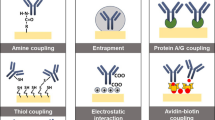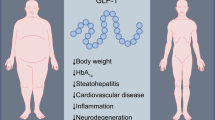Summary
The distribution and cellular location of substances reacting with anti-glucagon or anti-glicentin sera, i.e., glucagon-like and glicentin-like immunoreactivities, were studied in the human digestive tract using the immunofluorescence and immunoperoxidase methods. Both types of immunoreactivity were (1) absent in the antrum, (2) abundant in cells located at the periphery of pancreatic islets, (3) unevenly present in cells scattered in the epithelium of the small intestinal mucosa, the glicentin-immunoreactive cells being particularly abundant in the ileum. In the pancreas, and, when simultaneously present, in the intestine, both glucagon and glicentin immunoreactivities were located in the same cells.
The precise ultrastructural location of each immunoreactivity was readily made using colloidal gold and ferritin tracers on ultrathin sections of glutaraldehyde-osmium fixed and epoxy resin-embedded tissues. In the pancreas, both glucagon and glicentin immunoreactivities were found in the granules of the A-type cells; the glucagon immunoreactivity was only present in the core of the granule, whereas the glicentin immunoreactivity was found either in the peripheral halo only, or throughout the entire granule. In the small intestine, both immunoreactivities were located inside the granules of the L-type cells.
Quantitative specificity tests suggested that the glucagon- and the glicentin-like substances of the pancreas differ from those found in the intestine.
Similar content being viewed by others
References
Baetens D, Rufener C, Srikant BC, Dobbs R, Unger R, Orci L (1976) Identification of glucagon- producing cells (A cells) in dog gastric mucosa. J Cell Biol 69:455–464
Bloom SR (1974) Glucagon: pancreatic and enteric. Endocrinology of the gut. Chey WY, Brooks FP (eds), CB Slack Inc, pp 88–102
Bloom SR, Barnes AJ, Bryant MG, Alberti KGMM (1976) Plasma glucagon in diabetes resulting from total pancreatectomy. Metabolism 25, Suppl 1:1481–1482
Botha JL, Vinik AI, Child PT, Paul M, Jackson WPU (1977) Pancreatic glucagon-like immunoreactivity in a pancreatectomized patient. Horm Metab Res 9:199–205
Bussolati G, Capella C, Vassalo G, Solcia E (1971) Histochemical and ultrastructural studies on pancreatic A cells. Evidence for glucagon and non glucagon components of the α granule. Diabetologia 7:181–188
Garaud JC, Moody AJ, Eloy R, Grenier JF (1976) Unusual specificities of antibodies to glucagon- glutaraldehyde-albumin conjugates. Horm Metab Res 8:241–243
Garaud JC, Eloy R, Moody AJ, Grenier JF (1978) Cells immunoreactive to glucagon and GLI-1 antisera. A light and electron microscope study. Scand J Gastroenterol 13, Suppl 49:65
Garaud JC, Doerr-Schott J, Stock C, Grenier JF (1980) Immunocytochimie, techniques actuelles, possibilités nouvelles. Biol Cell 38: 15a
Garaud JC, Stock C, Grenier JF (1980) Reproducibility in staining ultra-thin sections: some easy improvements. Stain Technol (submitted for publication)
Geoghegan WD, Ackerman GA (1977) Adsorption of horseradish peroxidase, ovomucoid and anti- immunoglobulin to colloidal gold for the indirect detection of concavalin A, wheat germ agglutinin and goat anti-human immunoglobulin G on cell surfaces at the electron microscopic level: a new method, theory and application. J Histochem Cytochem 25:1187–1200
Goldman M (1968) Fluorescent antibody methods. Academic Press, New York London, pp 159–160 and 175–176
Graham RC, Karnovsky MJ (1966) The early stages of absorption of injected horseradish peroxidase in the proximal tubules of mouse kidney: ultrastructural cytochemistry by a new technique. J Histochem Cytochem 14:291–302
Holst JJ (1977) Extraction, gel filtration pattern, and receptor binding of porcine gastrointestinal glucagon-like immunoreactivity. Diabetologia 13:159–169
Jacobsen H, Demandt A, Moody AJ, Sundby F (1977) Sequence analysis of porcine gut GLI-1. Biochim Biophys Acta 493:452–459
Lane BP, Europa DL (1965) Differential staining of ultrathin sections of Epon-embedded tissues for light microscopy. J Histochem Cytochem 13:579–582
Lawrence AM, Tan S, Hojvat S, Kirsteins L, Milton J (1976) Salivary gland glucagon in man and mammals. Metabolism 25, Suppl 1:1405–1408
Lorén I, Alumets J, Håkanson R, Sundler F, Thorell J (1979) Gut-type glucagon immunoreactivity in nerves of the rat brain. Histochemistry 61:335–341
Miyata M, Yamamoyo T, Yamaguchi M, Nakao K, Yoshida T (1976) Plasma glucagon after total resection of the pancreas in man. Proc Soc Exp Biol Med 152:540–543
Moody AJ, Frandsen EK, Jacobsen H, Sundby F, Orci L (1976) The structural and immunologic relationship between gut GLI's and glucagon. Metabolism 25, Suppl 1:1336–1337
Moody AJ, Jacobsen H, Sundby F (1978a) Gastric glucagon and gut glucagon-like immunoreactants in gut. Gut Hormones. Bloom SR (Ed). Churchill Livingstone London New York, pp 369–378
Moody AJ, Sundby F, Jacobsen H, Lauritsen KB (1978b) The tissue distribution and plasma levels of glicentin (gut GLI-1). Scand J Gastroenterology 13, Suppl 49:127
Moody AJ, Frandsen E, Jacobsen H, Sundby F (1979a) Speculations on the structure and functions of gut GLI's. Rosselin G, Fromageot P, Bonfils S (eds) Hormone receptors in digestion and nutrition. Elsevier/North Holland, pp 55–64
Moody AJ, Jacobsen H, Sundby F (1979b) The possible functions of intestinal glucagon-like immunoreactants (Gut GLI's). Proceedings of the symposium “the entero-insular axis” Göttingen, September 7–8
Muller WA, Brennan MF, Tan MH, Aoki TT (1974) Studies of glucagon secretion in pancreatectomized patients. Diabetes 23:512–516
Palmer JP, Werner PL, Benson JW, Ensinck JW (1976) Immunoreactive glucagon responses to arginine in three pancreatectomized humans. Metabolism 25, Suppl 1:1483–1485
Pearse AGE (1968) Histochemistry. Theoretical and Applied. Third Edition. Volume 1, J and A Churchill Ltd, London, pp 32
Polak JM, Bloom S, Coulling I, Pearse AGE (1971a) Immunofluorescent localization of enteroglucagon cells in the gastrointestinal tract of the dog. Gut 12:311–318
Polak JM, Coulling I, Bloom SR, Pearse AGE (1971b) Immunofluorescence localization of secretin and enteroglucagon in human intestinal mucosa. Scand J Gastroenterol 6:739–744
Ravazzola M, Siperstein A, Moody AJ, Sundby F, Jacobsen H, Orci L (1979) Glicentin immunoreactive cells: their relationship to glucagon-producing cells. Endocrinology 105:499–508
Solcia E, Polak JM, Pearse AGE, Forssmann WG, Larsson L-I, Sundler F, Lechago J, Grimelius L, Fujita T, Creutzfeldt W, Gepts W, Falkmer S, Lefranc G, Heitz Ph, Hage E, Buchan AMJ, Bloom SR, Grossman MI (1978) Lausanne 1977 classification of gastroenteropancreatic endocrine cells. Bloom SR (ed) Gut Hormones. Churchill Livingstone, London New York, pp 40–48
Srikant CB, Unger RH (1976) Evidence for the presence of glucagon-like immunoreactivity (GLI) in the pancreas. Endocrinology 99:1655–1658
Sundby F, Jacobsen H, Moody AJ (1976) Purification and characterization of a protein from porcine gut with glucagon-like immunoreactivity. Horm Metab Res 8:366–371
Sutherland EW, De Duve C (1948) Origin and distribution of the hyperglycemic-glycogenolytic factor of the pancreas. J Biol Chem 175:663–674
Tager HS, Steiner DF (1973) Isolation of a glucagon-containing peptide: primary structure of a possible fragment of proglucagon. Proc Natl Acad Sci 70:2321–2325
Unger RH, Eisentraut AM, Sims K, McCall MS, Madison LL (1961) Sites of origin of glucagon in dogs and humans. Clin Res 9:53
Unger RH, Orci L (1976) Physiology and pathophysiology of glucagon. Physiol Rev 56:778–826
Valverde I, Rigopoulou D, Exton J, Ohneda A, Eisentraut A, Unger RH (1968) Demonstration and characterization of a second fraction of glucagon-like immunoreactivity in jejunal extracts. Am J Med Sci 255:415–420
Villanueva ML, Hedo JA, Marco J (1976) Plasma glucagon immunoreactivity in a totally pancreatectomized patient. Diabetologia 12:613–616
Author information
Authors and Affiliations
Additional information
Work supported by INSERM, A.T.P. number: 167539
Rights and permissions
About this article
Cite this article
Garaud, J.C., Eloy, R., Moody, A.J. et al. Glucagon- and glicentin-immunoreactive cells in the human digestive tract. Cell Tissue Res. 213, 121–136 (1980). https://doi.org/10.1007/BF00236925
Accepted:
Issue Date:
DOI: https://doi.org/10.1007/BF00236925




